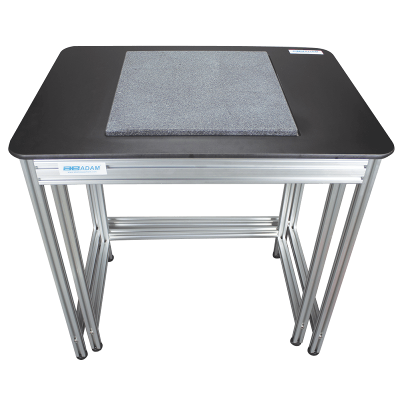
Lab balances are delicate instruments, and it’s a good idea to have a specific work area dedicated to taking measurements with such a precise tool. Having a dedicated workstation allows you to have all the important accessories and components readily accessible, and ensures you don’t waste any time setting up a new work-space or chasing down misplaced items. Before setting up a workstation, you may want to be sure the balance will not be moved from the area and that it is used frequently enough to warrant its own dedicated station.
Our top tips to creating your own lab balance workstation
1) Select your balance
Adam offers a selection of laboratory balances with capacities up to 32kg and readabilities as fine as 0.0001g to ensure you find the right one for your application. Equinox and Solis balances include many built-in weighing functions, such as percentage weighing, parts counting and density determination, that are ideal for including in your lab workstation. These semi-micro and analytical balances are suitable for labs performing highly advanced applications that require four or five place readability. Equinox features a touchscreen display with icon-driven menus. Solis has a graphical display that includes a capacity tracker on the screen. You can also use a Nimbus balance, available in precision and analytical models.

2) Add a calibration kit
Balances should be calibrated frequently, and the date of the calibration recorded and assessed for quality control, peer review and traceability. Be sure you have the proper calibration weights for your balance’s capacity and readability. Our certified weights meet traceability standards for calibrating precision, analytical and semi-micro balances. We recommend that you get a full calibration set, which comes in a case and includes gloves and/or forceps to handle the highly polished stainless steel weights properly (OIML or ASTM). If you need to replace a single weight or expand your kit, we also have individual weights.
Certain balances may be equipped with automatic internal calibration which effectively allows the balance to self-calibrate at regular intervals or at the touch of a button. This is often a preferred option for busy laboratory professionals to eliminate time consuming external calibration processes.

3) Use a sturdy surface
Our AVT anti-vibration table is designed to minimize vibrations from air currents or movement during measuring. Vibrations can cause readings to fluctuate, especially with precise instruments and small samples. Fluctuations in readings can also affect the calibration process.
Using an AVT provides a solid surface for consistent, precise measurements. The balance fits in the middle of the AVT’s granite surface, stabilizing the base and enabling greater precision. Its large, scratch-resistant dark granite slab sits on shock-absorbing rubber mounts, while levelling feet accommodate uneven surfaces. The table is composed of a 40x450mm inner working surface within a 597x767mm table top for accessories, note taking implements, and anything else you’d like to keep on the workstation.

4) Download data utility software for your balance
Adam DU (Data Utility) is a data collection program designed to quickly and easily capture data from Adam balances. Users can (among other things) graph data, perform statistical analysis and quickly export the readings to other applications. It can support eight different balances, six different users, allows for custom fields and, in some cases, remote operation of the balance. Adam DU is ideal for processing the raw data of your Adam balance.

The advantages of having a lab balance workstation
Having a dedicated workstation where calibration can also be performed will help ensure your balance is always calibrated properly. If you spend a lot of time taking acutely precise measurements, you want to make sure they’re not compromised by faulty calibration or fluctuations caused by your environment. A dedicated lab workstation is a good investment for lab professionals, and can save time and effort by ensuring the weighing process is as precise and accurate as possible.
Our blog includes articles that anyone using scales and balances may find useful. If you want to learn about specific balance features, are curious about GLP norms, or are looking for tips on how to care for your calibration weights, you’re only a click away. Don’t hesitate to contact us with any questions on our products.


